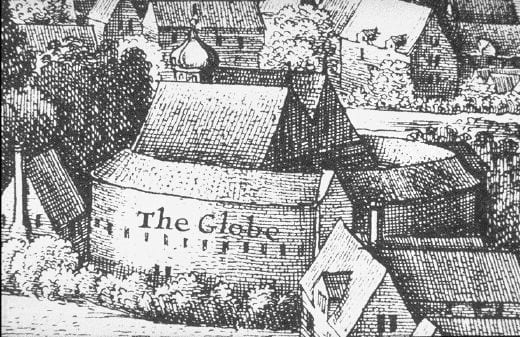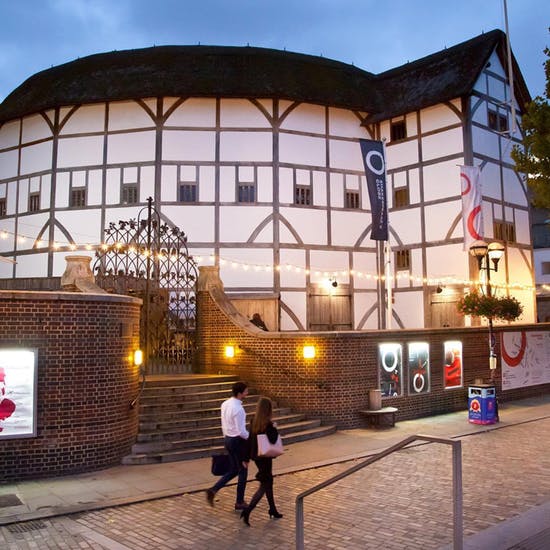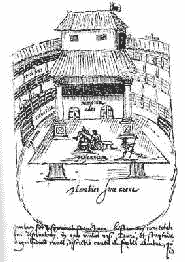This article gives an in-depth view of The Globe Theatre. If you’re after some quick, interesting facts on The Globe Theatre click here!
Drama at Shakespeare’s time – and at Shakespeare’s Globe Theatre – was characterised by a tug of war between a disapproving puritanical attitude to theatre by the city councillors on the one hand, and royal approval on the other. The city fathers resented royal patronage and regarded it as interference in their affairs. This battle went on until finally, in 1642 and 1644, all the theatres were destroyed under order of Parliament.
We have therefore had great difficulty in gaining a good picture of what Elizabethan theatres were really like. We don’t even know exactly where the Shakespeare’s Globe Theatre stood, although we can get quite close, and indeed, there is a splendid reconstruction of it, which is now one of London’s most popular theatres and biggest tourist attractions.
One of the most valuable sources of our knowledge about the actual architecture of the theatre is a drawing done by a Dutchman, Arend van Buchell, who did the drawing from a sketch made by his friend, Johannes de Witt, who attended a play at the Swan Theatre. Buchell said of it: ‘the largest and most remarkable of the theatres in London is the Swan, which is able to accommodate three thousand spectators.‘ This is his drawing:
After the old Globe Theatre was built in early 1599 the first production was As You Like It, followed by works by Shakespeare, Jonson, Beaumont, Fletcher, and others. In 1613, during a performance of Henry VIII, a cannon went off to mark the entrance of the king, and a stray spark set the thatch roof aflame. In one hour, the theatre was destroyed.
Reconstruction of the Globe began immediately, and it was finished by June 1614. Performances continued until 1642, when the Puritans, who found theatre vulgar and intolerable, shut all theatres down. Two years later the Globe was levelled to make way for tenement dwellings.
Plays were big business for those who owned them: Shakespeare was only one man who became rich from his involvement as a shareholder in the most popular theatre. The plays produced by the Globe were very high in quality and the theatre was always full.
The competition among the theatres created a huge demand for new material and is the single most important factor in the flowering of drama that is now known as the ‘golden age’ of English drama. Apart from Shakespeare’s, scores of the plays of that period are regularly performed today. This great demand is reflected in Shakespeare’s vast output. If you look at a timeline of Shakespeare’s life you will see how fast he worked. He wrote up to four plays in some years and averaged 1.5 plays a year during his working life.
A day out at the Globe Theatre was a real treat. The grounds around the theatre would have been bustling, with plenty of entertainment. Even people not attending performances would flock to the Globe for the market stalls and the holiday-like atmosphere. There were many complaints about apprentices missing work to go to the theatre.
The groundlings paid a penny to stand in the pit of the Globe Theatre. The others sat in the galleries. The very grand could watch the play from a chair set on the side of the stage itself. Theatre performances were held in the afternoon because they needed the daylight. The turnover of plays was unimaginable to the modern mind. The theatres could often present eleven performances of ten different plays in two weeks. The actors generally got their lines only as the play was in progress – very different from the well-rehearsed performances that we expect these days. There would be someone backstage whispering the lines and the actors would then repeat them. Women were not allowed to appear on the stage so the female roles were played by men and boys.
Shakespeare was not only a shareholder in the Globe and a prominent writer; he also acted in some of the plays. We don’t know exactly how many roles he played himself, although we do have some documented information.
Shakespeare had begun his career on the stage by 1592. It is probable that he played the title role in Edward I by Edward Peele in 1593. Regarding the major roles in his own plays, he was probably directing because he gave way to the other actors and played small, peripheral parts, including Adam in As You Like It; Duncan in Macbeth; King Henry in Henry IV Part 1and Part 2; and the ghost in Hamlet. Shakespeare’s first biographer, Nicholas Rowe, refers to a role by Shakespeare as ‘the Ghost in his own Hamlet’ and says that he was at ‘the top of his performance’.
Pictures of Shakespeare’s Globe Theatre – Then & Now

The Globe Theatre stage by night

Shakespeare’s Globe Theatre from 1700

Globe Theatre interior from 1700’s

Exterior of The Globe Theatre today
The 20th Century Rebuilding of Shakespeare’s Globe Theatre
In London Shakespeare circles there is a name almost as famous as that of William Shakespeare himself. It is that of Sam Wanamaker, an American actor whose vision almost matched Shakespeare’s.
A new acting space has opened in the Shakespeare Globe complex named ‘The Sam Wanamaker Playhouse.’ Near to the Globe on the south bank of the River Thames there is a plaque that reads: In Thanksgiving for Sam Wanamaker, Actor, Director, Producer, 1919–1993, whose vision rebuilt Shakespeare’s Globe Theatre on Bankside in this parish.
When Sam Wanamaker first visited London in 1949 he did what most first-time visitors did – he wandered around, overwhelmed by London’s beauty and history. One of the things he did was look for traces of Shakespeare’s Globe and he was astonished to find nothing more than a blackened plaque on a wall of an abandoned brewery. He failed to understand how Londoners, who should have been so proud of their famous writer, could be so neglectful.
While filming in the UK in 1952 he learned that he had become one of the many Hollywood victims of the McCarthy witch hunt and decided not to return to America. He had joined the Communist Party as a very young man and although he had long before abandoned that involvement it was enough for him to be blacklisted. So there was no career possible in America but he made a successful and distinguished career in the UK in film and theatre.
He became obsessed with his big idea – the resurrection of the lost Globe Theatre. In 1970 he launched the Shakespeare Globe Trust, and later obtained a piece of land near to the original site. He had considerable difficulty obtaining permission to build the theatre due to a hostile local council that blocked his efforts for years. He was also ridiculed by the theatre and film establishment but, undaunted, he carried on, using his own earnings from acting and directing to finance the project.





WHAT DID GLOBE THEATRE LOOK LIKE INSIDE?
AND HOW BIG WAS IT
The theater was as big as your fat head.
not needed mate
what was the atmosphere like in the globe
Very interesting. I like Shakespeare. He was a cool dude. I have to study him for school. This helped me a lot.
Hell yeah very cool dude, thanks for the information
i like. remeo and juliet
I prefer Hamlet and Macbeth.